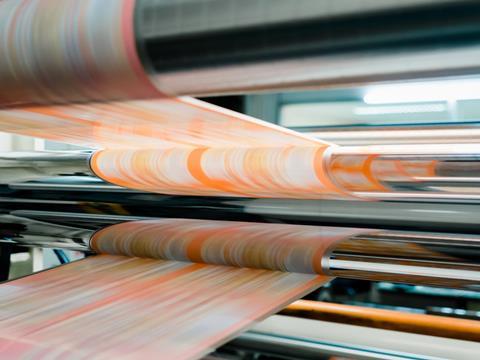
PrintCYC, a value chain initiative for the recycling of printed films whose members include Brückner Maschinenbau, Constantia Flexibles, Erema, Kiefel, PackSys Global, Profol, hubergroup says that it has achieved “remarkable results” regarding the recycling of printed plastic films and processing of recyclate.
The announcement of these results comes after project members joined forces to research and test new ways for creating what they describe as “circular economy solutions” based on post-industrial waste from printed plastic films in the most cost-effective manner.
In phase 1 of the project, PP film and packaging samples containing more than 50% of PP recyclate were successfully produced. The base material was printed biaxially oriented PP (BOPP) films on nitrocellulose (NC) based ink formulations.
Nevertheless, the group found that the resulting recyclate quality was not completely satisfying regarding material properties like colour, smell, and processability.
Based on the results from phase 1, PrintCYC members strived for further improvement by testing alternative ink formulations for printing on BOPP and Low Density Polyethylene (LDPE) films. Switching to a polyurethane (PU) based ink system in flexoprinting in phase 2 reportedly resulted in significant improvements of the mechanical recycling process on a production line which is typically used for reprocessing printed film waste materials in practice.
Due to the high temperature resistance of the inks, neither volatile by-products nor odour or gels were observed, leading to a new class of recyclates which showed colour stable properties. A first environmental impact assessment also reportedly showed decreased greenhouse gas emissions due to lower energy consumption of mechanical recycling of LDPE films compared to virgin material production.
According to the group: “These recyclates showed excellent processability for the production of blown films, cast films, and even biaxially oriented films, and were 100% comparable to virgin material. Up to 100% recyclate in the inner layer of a three-layered ABA film structure could be implemented successfully.”
The EU Plastics Strategy strives to increase the amount of recyclate in plastic products and packaging. Within the PrintCYC project, the impact of recyclate reuse in different packaging formats was also evaluated.
In phase 2 of PrintCYC, packaging formats such as flow packs, trays, yoghurt cups, and tubes have been produced, proving usage of rPP and rPE recyclates in processes such as sealing, thermoforming and compression moulding.
Currently, PrintCYC members are presenting the results to further value chain stakeholders for an exchange of expertise and eventually with the aim of winning new project partners. Another objective is to use the results for further development of design for recycling guidelines.










